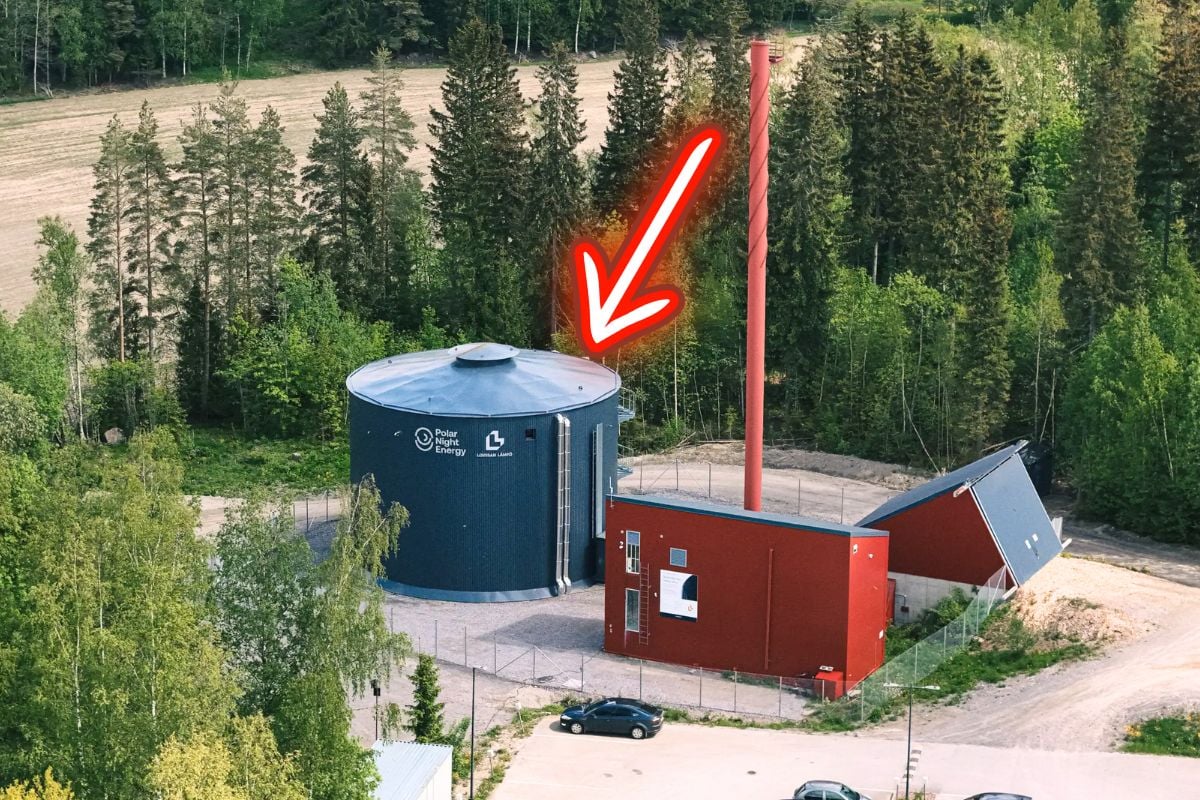Finland has achieved a groundbreaking milestone in renewable energy storage with the deployment of an extraordinary thermal storage system. This innovative technology represents a paradigm shift from traditional battery concepts, utilizing crushed soapstone as the primary storage medium. The massive installation in Pornainen demonstrates how industrial waste materials can become the foundation for revolutionary energy solutions.
Revolutionary thermal storage technology transforms energy landscape
The Finnish energy sector has embraced an unprecedented approach to power storage through this remarkable sand-based system. Unlike conventional lithium-ion batteries that rely on rare earth materials, this installation harnesses the thermal properties of soapstone waste from wood stove manufacturing. The cylindrical structure measures 13 meters in height and 15 meters in diameter, containing precisely 2,000 tons of this specialized material.
Polar Night Energy, the innovative startup behind this breakthrough, partnered with local energy provider Loviisan Lämpö to create this thermal battery revolution. The system operates by converting excess electricity into heat when renewable sources generate surplus power. During periods of high wind or solar production, electrical energy heats the soapstone to extreme temperatures, effectively storing thermal energy for later use.
This approach addresses the fundamental challenge of renewable energy intermittency while providing practical heating solutions for harsh Nordic climates. The technology demonstrates remarkable efficiency in maintaining stored heat for extended periods, making it particularly suitable for regions experiencing extreme seasonal temperature variations. Similar innovations in sustainable technology, such as China’s massive wind turbines, show how countries worldwide are developing large-scale renewable solutions.
The integration with existing district heating networks showcases the system’s practical applications. When temperatures drop significantly, the stored thermal energy transfers through established infrastructure to warm residential and commercial buildings. This seamless integration eliminates the need for extensive modifications to current heating systems while dramatically improving their environmental performance.
Impressive performance metrics demonstrate exceptional capabilities
The thermal storage facility delivers remarkable performance statistics that highlight its potential for widespread adoption. During summer months, the system can provide heating for an entire month, while winter operations maintain coverage for one full week. These figures become particularly impressive when considering Finland’s extreme winter conditions, where temperatures regularly drop to -25°C.
Environmental benefits extend beyond simple energy storage, with the system achieving a 70% reduction in local heating emissions. The installation eliminates fuel oil consumption entirely while reducing wood chip usage by 60%. This transformation results in annual savings of 160 tons of CO₂ emissions, contributing significantly to Pornainen’s ambitious goal of achieving climate neutrality by 2035.
SpecificationValueStorage Capacity100 MWhStructure Height13 metersStructure Diameter15 metersSoapstone Weight2,000 tonsSummer Coverage1 monthWinter Coverage1 weekCO₂ Reduction160 tons annually
Mayor Antti Kuusela expressed pride in the project’s smooth implementation and its alignment with municipal sustainability objectives. The initiative positions this small Finnish community as a pioneering example for European energy innovation, demonstrating how local solutions can address global challenges. Just as artificial intelligence transforms agriculture, this thermal storage technology represents a fundamental shift in energy management approaches.
Grid stabilization benefits enhance national energy security
Beyond local heating applications, this massive thermal battery plays a crucial role in national grid management. The system operates intelligently, responding to electricity market signals and grid reserve requirements managed by Finnish telecommunications company Elisa. This optimization ensures maximum utilization of renewable energy sources while providing essential grid stability services.
The technology addresses renewable energy’s inherent variability by storing excess power during peak production periods and releasing it when demand increases. This load balancing function proves essential for integrating higher percentages of wind and solar power into national energy systems. The installation operates silently without pollution or complex maintenance requirements, making it an ideal complement to existing infrastructure.
International interest in this technology continues growing, with Germany, Netherlands, and Canada exploring similar implementations. The success in Pornainen demonstrates scalability potential for larger urban areas seeking sustainable heating solutions. This growing global interest mirrors developments in other cutting-edge technologies, such as space-based solar observation systems and solar pole imaging technology.
Sustainable material usage exemplifies circular economy principles
The project’s environmental credentials extend beyond operational efficiency to include sustainable material sourcing. The soapstone filling consists entirely of industrial waste from wood stove manufacturing, transforming what would otherwise become landfill material into valuable energy storage medium. This approach exemplifies circular economy principles by creating value from waste streams.
This material choice avoids environmental controversies associated with large-scale sand extraction, which increasingly threatens global ecosystems. By utilizing locally available industrial byproducts, the project reduces transportation emissions while supporting regional economic development. The approach offers a replicable model for other regions with similar industrial waste streams.
Key advantages of this sustainable approach include:
Zero primary material extraction requirements
Reduced transportation environmental impact
Support for local circular economy initiatives
Elimination of industrial waste disposal costs
Enhanced community energy independence
The installation’s success demonstrates how innovative thinking can transform industrial waste into critical infrastructure components. This approach aligns with broader sustainability trends, including developments in sustainable sports field materials, showing how various industries are reimagining waste as resources.
Finland’s achievement with this 100 MW thermal storage system establishes new benchmarks for renewable energy integration and sustainable heating solutions. The project proves that effective energy storage doesn’t require exotic materials or complex technologies, instead leveraging simple physics and abundant waste materials to create powerful infrastructure solutions.
